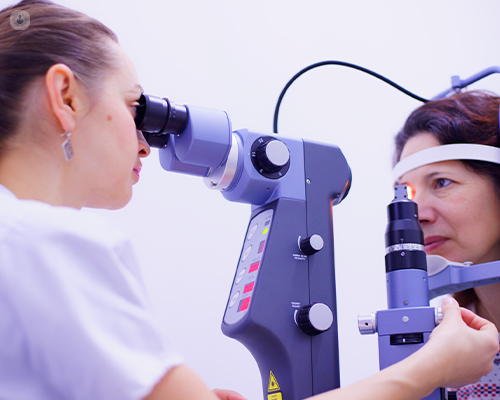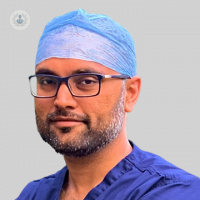All about epiretinal membranes (cellophane maculopathy)
Escrito por:Leading consultant ophthalmologist, cataract and vitreoretinal surgeon Mr Kirti M Jasani takes a look at epiretinal membranes in expert detail.

What are epiretinal membranes?
Epiretinal membranes (also known as macular pucker or cellophane maculopathy) are fine membranes that grow on the surface of your retina. They can be distorted and contort retinal structures, which results in vision being made blurry and distorted.
Who gets it?
Men and women are equally affected, and it is more common over the age of 60. Incidence continues to rise with age with estimates saying 20 per cent of all people over 75 years have a degree of it, though the vast majority will be visually insignificant.
What causes it?
No cause is identified in most cases. However, it can occasionally be linked with:
- posterior vitreous detachment;
- previous retinal laser treatment;
- retinal tears;
- retinal vascular occlusions;
- inflammation;
- injury and;
- usage of cryotherapy.
What are the symptoms of epiretinal membranes?
The majority of epiretinal membranes are mild and hence patients are relatively asymptomatic. However, it can affect the structure of the retina as it grows. This results in blurred and distorted vision to a variable degree. Patients may also complain of a difference in the size of objects between both eyes.
How are epiretinal membranes treated?
Treatment for epiretinal membrane is surgical but varies according the severity of the membrane and also the degree of patient symptoms. If patients have no significant complaints and are coping well with their vision, then surgery isn’t recommended. This because it won’t improve their vision and associated quality of life. However, a choice is usually made between observation or surgery if patients are symptomatic. This will be discussed during your initial consultation.
What does surgery for epiretinal membranes involve?
Epiretinal membrane surgery involves mechanically peeling away the membrane from the surface of the retina. The vitreous part of the eye (the gel that fills the cavity at the back of the eye) is removed in a procedure called vitrectomy, in order to gain access to the membrane. This is performed using three “keyhole” incisions in the eye, of around 0.5mm each, and vitreous gel is removed. The epiretinal membrane is then peeled off the retina by using micro-forceps.
Then, the peripheral retina is analysed for any retinal tears. If retinal tear(s) are found in the periphery (usually in about 5 per cent of cases), they are treated (with laser or cryotherapy) and a gas bubble is placed in the eye. If there are no retinal tears, no gas bubble is placed in the eye.
The procedure can be undertaken either under local anaesthetic (patient is awake) or general anaesthetic (patient is asleep). The surgery usually takes approximately one hour to perform. If there’s a significant cataract in the same eye as the epiretinal membrane, it can be removed at the same time.
How successful is surgery?
Surgery is done with the primary aim of stabilising vision and any improvement is regarded as a bonus.
The vast majority of patients (up to 80 per cent) notice their vision and distortion to improve gradually over the course of 6 to 9 months. However, vision doesn’t reach the levels it was previous to the development of the epiretinal membrane, despite surgery.
What happens if no surgery is undertaken?
As mentioned above, most epiretinal membranes are mild and only 10-20 per cent of patients progress to require surgical intervention. If it’s left untreated, however, vision will remain blurred and/or distorted in the affected eye. Plus, it might worsen over time. If it does, any surgery is unlikely to help regain the loss.
Do you require expert treatment for epiretinal membranes? Arrange a consultation with Mr Jasani via his Top Doctors profile.


